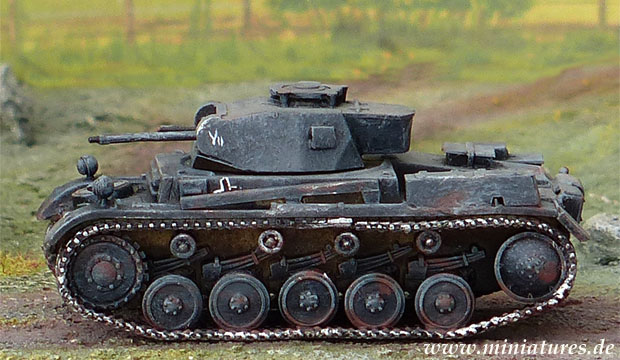Panzer II Ausf. F, German Light Tank Sd.Kfz. 121
Matchbox 1:76 Scale Vehicle Review

Panzerkampfwagen II were produced in larger numbers than originally expected, to serve as a stopgap vehicle until production of the Pz.Kpfw. III and IV series picked up. The earlier Ausf. II.A had been used as the main battle tank in Poland, but it was no match for the heavily armoured Char B1 and Somua tanks which the Wehrmacht encountered in France the following year. Pz.Kpfw. II.F received better frontal armour and many of the older Ausf. A, B and C were uparmoured to this standard as well. From 1940, the vehicle served primarily in reconnaissance platoons of five Pz.Kpfw. II.F attached to Panzer companies, battalions and regiments. For the invasion of Russia a flamethrower variant, the Pz.Kpfw. II(Fl) was produced. Surviving vehicles were withdrawn from the Eastern Front in 1942 and converted to Marder II tank destroyers, mounting a 7.5 cm PaK 40.
Contents
Two miniatures, diorama base and Pz.Kpfw. II Ausf. F
- Type: Main Battle Tank
- Length: 4.80 m
- Width: 2.29 m
- Height: 2.00 m
- Weight: 9.5 t
- Armament: 2 cm L/55, MG 34
- Road Speed: 40 km/h
- 3 Crew: Commander, Gunner and Driver
- Year: 1940–1943
Evaluation
Scale model with much raised detail and some external stowage.
Good choice of subject, a very important and versatile model.
Choice of open or closed turret hatches.
Compatible with Airfix, Fujimi, Nitto, and VAC-U-CAST.
Many small parts make this a more difficult vehicle to build. Road wheels need to dry at least 24 hours before the tracks are fitted. It is best to skip step 3 of the assembly process initially and return to it after the vehicle is finished.
The 2 cm gun (part #14) does not have a peg which fits into the mantlet, it must be trimmed to the right length and then carved to a point which will fit into the hole.
The body assembly proved more difficult than expected. The upper deck did not fit well onto the lower hull and track assembly, large cracks appeared. Clothes-pins had to be applied to hold the deck firmly in place while it dried.
Vehicle commander not included. The tank may be modelled with an open turret hatch, it would have been nice to mount a figure in it.
Approximately 5 % smaller than the 1:72 scale figure standard. Not a problem in this case, the vehicle is the only one on the market and it may be deployed in formation alongside Pz.Kpfw. I and Pz.Kpfw. III produced by Fujimi and Matchbox.
Historical Employment
- Aufklärungszug (Reconnaissance Platoon) of five Pz.Kpfw. II Ausf. F
- Panzerkompanie, 1940–1942
- Panzerbataillon, 1940–1943
- Panzerregiment, 1940–1943
- X. Panzer Division, 14. Panzer Korps, Eastern Front, Summer 1941
- XV. Panzer Division, Afrika Korps, April 1942
Possible Conversions
- Pz.Kpfw. II Ausf. A, 1939–1940 (tank platoon of five vehicles)
- Pz.Kpfw. II(Fl) (Flamingo), flamethrower, Eastern Front June 1941 – March 1942
- Pz.Kpfw. II Ausf. G(?), rearmed with a captured French 37 mm L/33 gun. The gun was mounted centrally through the existing mantlet, and the tank lost its coaxial MG. In 1941, one each of these vehicles was issued to Pz.Kpfw. II platoons.
- Sd.Kfz. 131, Marder II (tank-hunter) with 7.5 cm PaK 40, May 1942–1945
- Pz.Kpfw. II Ausf. L (Lynx), reconnaissance vehicle with 2 cm L/55, 1944–1945
The Pz.Kpfw. II is an important vehicle which saw much more combat than expected. The vehicle had an interesting and varied career, which began as a main battle tank during the 1939 invasion of Poland. Less than a year later, Pz.Kpfw. II were relegated to reconnaissance duties in Panzer formations now operating the mass produced Pz.Kpfw. III.F as their new main battle tank. Flamethrower, reconnaissance and tank-hunter conversions extended the service life of the vehicle until the end of the war. Compared to other Matchbox kits, this particular vehicle is relatively difficult to build and it requires carful attention and patience from the hobbyist. Since many Pz.Kpfw. II and Marder II conversion will be required for wargaming purposes, we recommend that entire platoons of them are produced in assembly-line fashion. Given some experience with the kit, the model builder will achieve more consistent results in less time per vehicle.